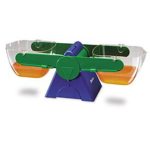The Bucket Balance
 I lived in a small village in Mali near the Guinean border. Not far from my village was a gold mining town, like the old west, except not at all like the old west. Imagine holes in the ground about 24 inches wide and 15 to 20 feet deep, where people climb down with small buckets to dredge up mud. From there, those buckets are passed toward the sunlight where other gold miners pan through the mud for specks of gold. It is unlike anything you can imagine, especially when you think that most of the people who have to go deep into the earth are young children… they are small enough to fit.
I lived in a small village in Mali near the Guinean border. Not far from my village was a gold mining town, like the old west, except not at all like the old west. Imagine holes in the ground about 24 inches wide and 15 to 20 feet deep, where people climb down with small buckets to dredge up mud. From there, those buckets are passed toward the sunlight where other gold miners pan through the mud for specks of gold. It is unlike anything you can imagine, especially when you think that most of the people who have to go deep into the earth are young children… they are small enough to fit.
In designated areas, there are gold mining barons, who sit perched in a squat all day waiting for those specks of gold to be weighed. Everyone uses a traditional balance scale, putting the gold on one side and the small weights on the other, until balanced. It is fascinating to watch. Everyone involved in the process can eyeball the gold dust and know exactly how much it is worth.
Balances and scales are rich with opportunities for children to consider weight and size. Remember, young children are fooled by appearances, so they may think that something that is “bigger” may weigh more, while that might not be true at all.
Learning Resources says of the Bucket Balance that it is “Perfect for exploring basic measurement concepts.” Children can measure, explore volume and compare solids and liquids.
I like to put the bucket balance in both the water and the sand tables. Children explore filling and dumping while trying to get it to balance in the middle.
Here is a great lesson plan on using the bucket balance
How do you use the Bucket Balance?
I would love to have a balance like this one in my classroom.
